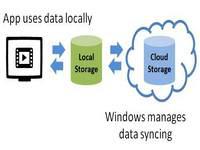
In the latest post on the Windows 8 app developer blog, Microsoft explains how to implement roaming into Windows 8 apps.
If you’re building a Windows 8 app, Microsoft is pretty much holding your hand so the app doesn’t get rejected or have negative user feedback
We’ve been tracking Microsoft’s post over at the Windows 8 app developer blog, and the latest installments talks about how roaming can be implemented into apps. Roaming data is when Wi-Fi connections aren’t available, and you use a cellular service such as 4G.
Microsoft says it’s goal with roaming is to make it easy when connected to the cloud, and is actually taking the control away from the develop so they don’t have to configure roaming settings.
Windows 8 has what Microsoft describes as an integrated roaming sync for Application Data for Metro apps using a connected Microsoft Account (your login ID). This ApplicationData is split into three types – local (Wi-Fi), roaming (3G, 4G etc.) and temporary. Microsoft added when users connect to Windows, they all connected to the app.
Creating Consistent Experiences
Roaming data also has a per-app data storage, and the limits ensure that battery life and performance are not compromized. The quota currently is around 100KB, and Microsoft says developers should ensure at the design stage the quota won’t be exceeded. A common problem Microsoft sees with apps is that they scan the whole articles rather than identifiers; basically, scanning the whole articles uses more data.
Microsoft also talked about creating a continuous experience across PCs, citing an example where someone is reading another person’s RSS feed before they have to catch a bus. There’s the ability for developers to create this experience across devices, and Microsoft includes a line of code for Javascript and C# (check out the source link, below).
Windows will warn of any changes when roaming, so it means there won’t be an inconsistency across devices using the same RSS feed (for example) and you’ll be able to refresh when the problem is corrected. Microsoft reiterates that the experience is optimized for alternative between the devices, not using two or more in real time.
Windows 8 launches late October; the Release Preview is available to download now. For a full guide on implementing roaming, click the source link below.

